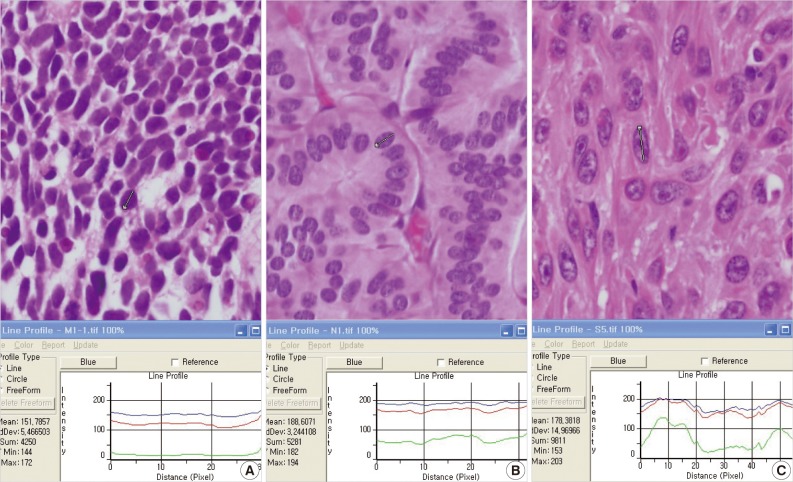Articles
- Page Path
- HOME > J Pathol Transl Med > Volume 46(1); 2012 > Article
-
Original Article
Nuclear Image Analysis Study of Neuroendocrine Tumors - Meeja Park, Taehwa Baek, Jongho Baek, Hyunjin Son, Dongwook Kang, Jooheon Kim, Hyekyung Lee
-
Korean Journal of Pathology 2012;46(1):38-41.
DOI: https://doi.org/10.4132/KoreanJPathol.2012.46.1.38
Published online: February 23, 2012
Department of Pathology, Eulji University Hospital, Eulji University School of Medicine, Daejeon, Korea.
- Corresponding Author: Hyekyung Lee, M.D. Department of Pathology, Eulji University Hospital, Eulji University School of Medicine, 1306 Dunsan-dong, Seo-gu, Daejeon 302-799, Korea. Tel: +82-42-611-3460, Fax: +82-42-611-3459, apw01@hanmail.net
© 2012 The Korean Society of Pathologists/The Korean Society for Cytopathology
This is an Open Access article distributed under the terms of the Creative Commons Attribution Non-Commercial License (http://creativecommons.org/licenses/by-nc/3.0) which permits unrestricted non-commercial use, distribution, and reproduction in any medium, provided the original work is properly cited.
Figure & Data
References
Citations

- Difference of the Nuclear Green Light Intensity between Papillary Carcinoma Cells Showing Clear Nuclei and Non-neoplastic Follicular Epithelia in Papillary Thyroid Carcinoma
Hyekyung Lee, Tae Hwa Baek, Meeja Park, Seung Yun Lee, Hyun Jin Son, Dong Wook Kang, Joo Heon Kim, Soo Young Kim
Journal of Pathology and Translational Medicine.2016; 50(5): 355. CrossRef - Comparison of diagnostic accuracy between CellprepPlus® and ThinPrep® liquid‐based preparations in effusion cytology
Yong‐Moon Lee, Ji‐Yong Hwang, Seung‐Myoung Son, Song‐Yi Choi, Ho‐Chang Lee, Eun‐Joong Kim, Hye‐Suk Han, Jin young An, Joung‐Ho Han, Ok‐Jun Lee
Diagnostic Cytopathology.2014; 42(5): 384. CrossRef

Fig. 1


RGB, red, green, and blue.
Data shown as mean±standard deviation. A one-way analysis of variance (ANOVA) is used for comparing the parameters for multiple groups. The p-value<0.05 is considered to be significant. RGB, red, green, and blue; NET, neuroendocrine tumor; SCC, small cell carcinoma; SqCC, squamous cell carcinoma.

 E-submission
E-submission



 PubReader
PubReader Cite this Article
Cite this Article


